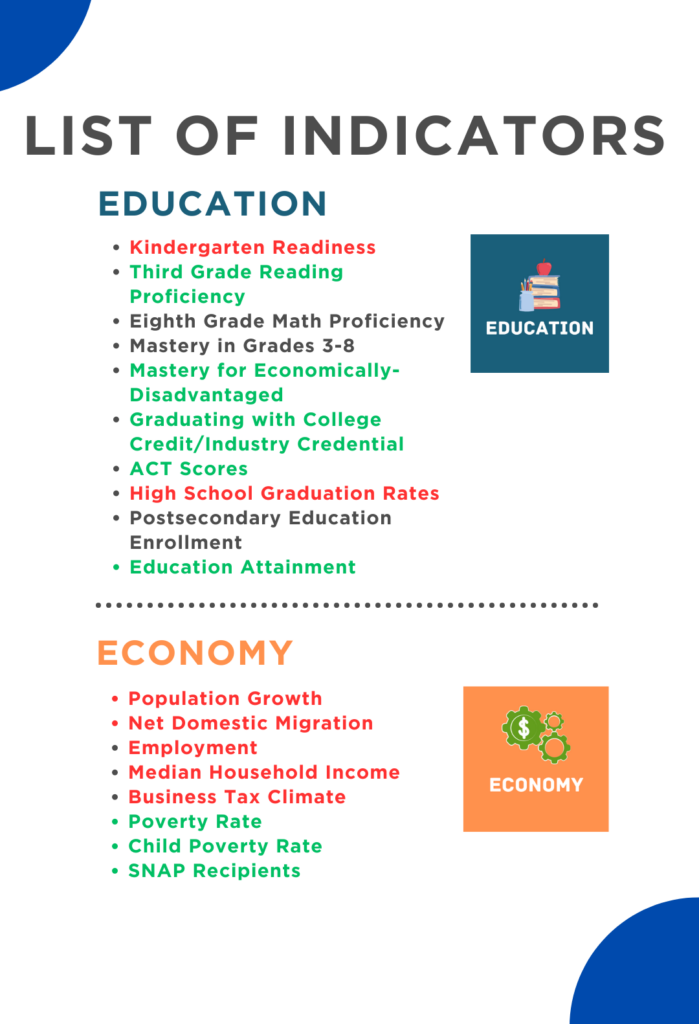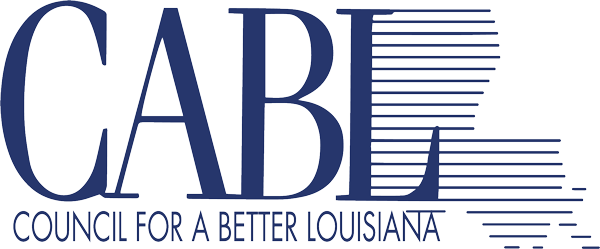
The Council for A Better Louisiana’s list of 35 indicators designed to measure the overall wellbeing of Louisiana is trending slightly downward from this time last year. Compared to our release in August of 2023 the state is making progress on just under half of the indicators and losing ground on the same number. A few remain unchanged.
The findings come from CABL’s Louisiana Fact Book: Facts for the Future, an online resource that monitors the state’s progress in five key areas:
- Education & Workforce
- Economy
- Health & Wellbeing
- Infrastructure
- Environment & Energy
One year after the Fact Book’s inception, it shows that 16 indicators are trending downward compared to 13 in August 2023. Seven were down for two years in a row. Similarly, 16 are trending upward compared to 18 the prior year. Eight showed progress for two straight years while three remained unchanged.
 Since data for various indicators is updated at different times of the year, some of the indicators have no updates. For those we recorded the same trend results as were seen in the prior year. Still, when viewed collectively, the indicators paint a picture of Louisiana that can help us assess the challenges we are currently facing and help us understand the priorities we must focus on to create a better state.
Since data for various indicators is updated at different times of the year, some of the indicators have no updates. For those we recorded the same trend results as were seen in the prior year. Still, when viewed collectively, the indicators paint a picture of Louisiana that can help us assess the challenges we are currently facing and help us understand the priorities we must focus on to create a better state.
“While there are certainly bright spots within this list of indicators, the general message is that we are not seeing the progress we need,” said Barry Erwin, CABL President. “We should be moving up or at least holding our ground on all of these indicators, but the fact that we are going in the wrong direction on nearly half of them should be a wakeup call for all of us. This is particularly true since Louisiana already ranks low compared to other states on many of these items, including a large number of the ones where the state saw declines.”
During the course of CABL’s tracking, Louisiana has seen progress on five of the 10 indicators measuring outcomes in education and the workforce. Most encouraging is that Louisiana’s scores in third grade reading, an area that has received a great deal of recent attention, have trended up six points since 2022. The percentage of economically-disadvantaged students in grades 3-8 performing at Mastery or above has grown four points during that same period.
That outpaces the growth of the student population as a whole, but lower income students are still about eight points behind their peers, overall.
Another highlight is the continued growth in the education attainment rate for the working-age population which is just shy of 50%. Meanwhile, performance has stayed about the same on three indicators, while losing ground on two.
In terms of the economy, it’s more of a mixed bag. There seems to be improvement for those at the lower end of the economic spectrum. Poverty rates are down and income rose by almost 3.5%, though that was at a lower rate than the rest of the country.
But the broader barometers of the state’s economic wellbeing show concerning trends. Population loss and outmigration are a continuing problem. Employment growth has been almost non-existent over the last decade, and while it did tick up .5% over the last year, that was far less than what was seen in almost every southern state and well behind the U.S. growth rate of 1.7%. After recent improvement, Louisiana fell in the Tax Foundation’s ranking for State Business Tax Climate.
Employment growth has been almost non-existent over the last decade, and while it did tick up .5% over the last year, that was far less than what was seen in almost every southern state and well behind the U.S. growth rate of 1.7%. After recent improvement, Louisiana fell in the Tax Foundation’s ranking for State Business Tax Climate.
At the same time, Louisiana continues to fare poorly in most measures of health and overall wellbeing, but the state’s violent crime rate and prison recidivism rates both showed improvement.
“While you could characterize this year’s results as only slightly lower than last year’s, you can’t ignore the fact that that we need to be moving up,” Erwin said. “We have created a sense of urgency and developed new policies around things like education and are seeing some progress. But we need the same thing in other areas, particularly addressing our chronic loss of population, creating more jobs, and fixing our uncompetitive tax structure.”
Each indicator CABL tracks comes with an individual data point, an explanation of why it is important, and an arrow showing if the state has improved or declined over the previous year. Each data point is supplemented with a corresponding note that provides additional background and recent trends. Taken as a whole, they are intended to help citizens and policy makers understand how we compare with other states and if we are seeing progress.
CABL believes the breadth of issues included in the Louisiana Fact Book can help provide clarity on the things that are holding us back, recognize progress where we see it, and highlight the challenges we must overcome to make Louisiana the dynamic and prosperous state every citizen deserves.
